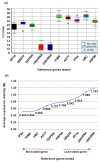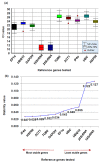Evaluation and validation of housekeeping genes as reference for gene expression studies in pigeonpea (Cajanus cajan) under drought stress conditions
- PMID: 25849964
- PMCID: PMC4388706
- DOI: 10.1371/journal.pone.0122847
Evaluation and validation of housekeeping genes as reference for gene expression studies in pigeonpea (Cajanus cajan) under drought stress conditions
Abstract
Gene expression analysis using quantitative real-time PCR (qRT-PCR) is a very sensitive technique and its sensitivity depends on the stable performance of reference gene(s) used in the study. A number of housekeeping genes have been used in various expression studies in many crops however, their expression were found to be inconsistent under different stress conditions. As a result, species specific housekeeping genes have been recommended for different expression studies in several crop species. However, such specific housekeeping genes have not been reported in the case of pigeonpea (Cajanus cajan) despite the fact that genome sequence has become available for the crop. To identify the stable housekeeping genes in pigeonpea for expression analysis under drought stress conditions, the relative expression variations of 10 commonly used housekeeping genes (EF1α, UBQ10, GAPDH, 18SrRNA, 25SrRNA, TUB6, ACT1, IF4α, UBC and HSP90) were studied on root, stem and leaves tissues of Asha (ICPL 87119). Three statistical algorithms geNorm, NormFinder and BestKeeper were used to define the stability of candidate genes. geNorm analysis identified IF4α and TUB6 as the most stable housekeeping genes however, NormFinder analysis determined IF4α and HSP90 as the most stable housekeeping genes under drought stress conditions. Subsequently validation of the identified candidate genes was undertaken in qRT-PCR based gene expression analysis of uspA gene which plays an important role for drought stress conditions in pigeonpea. The relative quantification of the uspA gene varied according to the internal controls (stable and least stable genes), thus highlighting the importance of the choice of as well as validation of internal controls in such experiments. The identified stable and validated housekeeping genes will facilitate gene expression studies in pigeonpea especially under drought stress conditions.
Conflict of interest statement
Figures



Similar articles
-
Selection and Validation of Housekeeping Genes as Reference for Gene Expression Studies in Pigeonpea (Cajanus cajan) under Heat and Salt Stress Conditions.Front Plant Sci. 2015 Dec 21;6:1071. doi: 10.3389/fpls.2015.01071. eCollection 2015. Front Plant Sci. 2015. PMID: 27242803 Free PMC article.
-
Gene expression analysis for selection and validation of suitable housekeeping gene(s) in cadmium exposed pigeonpea plants inoculated with arbuscular mycorrhizae.Plant Physiol Biochem. 2021 May;162:592-602. doi: 10.1016/j.plaphy.2021.03.024. Epub 2021 Mar 15. Plant Physiol Biochem. 2021. PMID: 33773234
-
Selection and validation of reference genes for normalization of qRT-PCR gene expression in wheat (Triticum durum L.) under drought and salt stresses.J Genet. 2018 Dec;97(5):1433-1444. J Genet. 2018. PMID: 30555091
-
Validation of Housekeeping Genes for Gene Expression Profiling in Fish: A Necessity.Crit Rev Eukaryot Gene Expr. 2019;29(6):565-579. doi: 10.1615/CritRevEukaryotGeneExpr.2019028964. Crit Rev Eukaryot Gene Expr. 2019. PMID: 32422011 Review.
-
Consensus reference gene(s) for gene expression studies in human cancers: end of the tunnel visible?Cell Oncol (Dordr). 2015 Dec;38(6):419-31. doi: 10.1007/s13402-015-0244-6. Epub 2015 Sep 18. Cell Oncol (Dordr). 2015. PMID: 26384826 Review.
Cited by
-
Understanding the Role of the WRKY Gene Family under Stress Conditions in Pigeonpea (Cajanus Cajan L.).Plants (Basel). 2019 Jul 10;8(7):214. doi: 10.3390/plants8070214. Plants (Basel). 2019. PMID: 31295921 Free PMC article.
-
Selection of reference genes for quantitative real-time PCR normalization in Narcissus pseudonarcissu in different cultivars and different organs.Heliyon. 2018 Jul 9;4(7):e00686. doi: 10.1016/j.heliyon.2018.e00686. eCollection 2018 Jul. Heliyon. 2018. PMID: 29998201 Free PMC article.
-
Genome-Wide Identification, Genomic Organization, and Characterization of Potassium Transport-Related Genes in Cajanus cajan and Their Role in Abiotic Stress.Plants (Basel). 2021 Oct 20;10(11):2238. doi: 10.3390/plants10112238. Plants (Basel). 2021. PMID: 34834601 Free PMC article.
-
Gene expression atlas of pigeonpea and its application to gain insights into genes associated with pollen fertility implicated in seed formation.J Exp Bot. 2017 Apr 1;68(8):2037-2054. doi: 10.1093/jxb/erx010. J Exp Bot. 2017. PMID: 28338822 Free PMC article.
-
Genome-wide identification and expression profiling of growth‑regulating factor (GRF) and GRF‑interacting factor (GIF) gene families in chickpea and pigeonpea.Sci Rep. 2024 Jul 26;14(1):17178. doi: 10.1038/s41598-024-68033-2. Sci Rep. 2024. PMID: 39060385 Free PMC article.
References
Publication types
MeSH terms
LinkOut - more resources
Full Text Sources
Other Literature Sources
Research Materials

